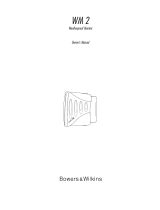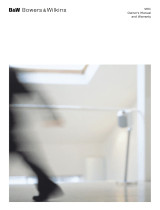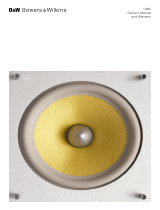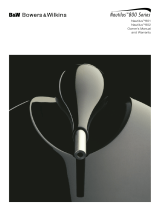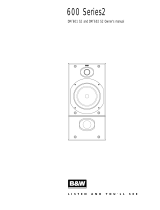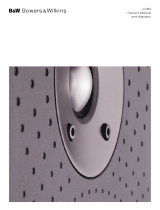Page is loading ...

CT700 Series
CT7.3 LCRS
CT7.4 LCRS
CT7.5 LCRS
Installation Manual

&IGURE
&IGURE
&IGURE
M
IN
M
IN
&IGURE
&IGUREB
.EUTRIK
3PEAKON
#ONNECTOR
.,&#
&IGURE
O
LC S E
&IGUREA

Contents
English
Installation manual ........2
Limited Warranty...........3
Français
Manuel d’utilisation.......4
Garantie limitée.............6
Deutsch
Bedienungsanleitung.....7
Garantie .......................9
Español
Manual de
instrucciones ..............10
Garantía limitada.........12
Português
Manual de instalação ..13
Garantia limitada.........15
Italiano
Manuale di istruzioni ...16
Garanzia limitata .........18
Nederlands
Installatie Handleiding .19
Garantie .....................21
Ελληνικά
δηγίες
εγκατάστασης .........22
Περιρισµένη
εγγύηση....................24
Русский
Руководство по
эксплуатации ............25
Ограниченная
гарантия....................27
"esky
Návod k pouãití..........28
Záruka .......................30
Polski
Instrukcja
uÃytkownika ...............31
Gwarancja .................33
.......................34
.......................35
.......................36
.......................37
EU Declaration of
Conformity..................40
Response Charts........41
Technical
Specifications .......42–44
7105 CT7X IM Inner Iss3.qxd 11/9/08 9:23 am Page 1

English
Installation manual
Dear customer,
Thank you for choosing Bowers & Wilkins. Please read
this manual fully before unpacking and installing the
product. It will help you to optimise its performance.
B&W maintains a network of dedicated distributors in
over 60 countries who will be able to help you should
you have any problems your dealer cannot resolve.
Environmental Information
All B&W products are designed to comply
with international directives on the
Restriction of Hazardous Substances
(RoHS) in electrical and electronic equipment and the
disposal of Waste Electrical and Electronic Equipment
(WEEE). These symbols indicate compliance and that
the products must be appropriately recycled or
processed in accordance with these directives. Consult
your local waste disposal authority for guidance.
Carton Contents
Check in the carton for:
4 Adhesive rubber feet
2 Adhesive rubber spacers
2 Port plugs
1 Speakon
®
plug
2 Wall brackets
4 M6 bolts
Speaker Installation
CT700 Series speakers can either be installed within
existing or custom designed home theatre system
cabinets, or wall mounted using a variety of brackets.
If the speakers are to be installed within a cabinet it is
important to ensure that it is capable of carrying their
weight and that it is structurally sound. Significant
vibration of the cabinet panels may seriously affect the
subjective performance of the speakers. Figure 1
illustrates the installation of three CT700 Series
speakers in a home theatre cabinet showing the
recommended dimensions between the speakers and
space around them.
Adhesive rubber feet are supplied for attachment to the
underside of the speakers in order both to protect the
cabinet finish and to reduce vibration. Attach one
adhesive foot at each underside corner of the speakers.
If gaps wider than approximately 20mm (3/4 inch)
remain around a speaker when it has been installed in a
cabinet, the acoustic performance will be improved if
the gaps are filled. Use carefully cut pieces of
upholstery or acoustic foam to fill the gaps as far back
as is practical and flush with the front panel of the
speaker. Only use foam with an appropriate fire safety
rating.
CT700 Series speakers can also be wall mounted using
one of two methods.
Wall Brackets:
The speakers incorporate 4 M6 tapped inserts in their
back panels for attachment of the two brackets
supplied. Always use both brackets. Use the supplied
M6 bolts to attach the brackets to the back of the
speaker. The two supplied adhesive rubber spacers can
be used to cushion the speaker against the wall.
Figure 3 illustrates use of the brackets. Before using the
brackets ensure that the wall and fixings are capable of
supporting the weight of the speaker. B&W can accept
no liability for any failure of wall and/or fixings.
Ball-joint Brackets:
The speakers incorporate 4 M6 tapped inserts in their
undersides that enable the speakers to be wall-
mounted using adjustable ball-joint style mounting
brackets designed for 127mm x 69.9mm (5 in x 2.75 in)
mounting hole centres. Your dealer or local B&W
distributor will be able to advise you on the selection of
appropriate brackets.
To attach a ball-joint style bracket to a CT700 Series
speaker first securely attach the socket plate to the
underside of the speaker. Figure 4 illustrates this
procedure.
Once the socket plate is attached to the speaker, the
assembly may be connected to the ball component
attached to the wall. Ensure that the manufacturer’s
instructions for attaching the bracket to the wall are
followed correctly and that the wall and fixings are
capable of supporting the weight of the speaker. B&W
can accept no liability for any failure of wall and/or
fixings.
Regardless of the style of installation take care when
lifting the speakers into position. They are unwieldy and
heavy and best handled by two people working
together.
The black fabric grilles are attached by magnets and
may be removed if desired. Take care not to touch the
drive units when removing or replacing the grilles.
Speaker Positioning
CT700 Series speakers used for the front left and
right channels in a home theatre system should be
positioned one either side of the screen on the
horizontal centre-line. They should be within
approximately 0.5m (20 in) of the sides of the screen
to help keep the sound image in scale with the visual
image. See Figures 1 and 2.
A CT700 Series speaker used for the centre channel in
a home theatre system should be positioned centrally
either directly above or below the screen. In the case
of acoustically transparent screens, the centre channel
speaker should be positioned centrally behind the
screen.
CT700 Series speakers used for the surround
channels in a home theatre system should be
positioned above and to either side or behind the
listening position.
2
7105 CT7X IM Inner Iss3.qxd 11/9/08 9:23 am Page 2

Stray Magnetic Fields
The speaker drive units create stray magnetic fields
that extend beyond the boundaries of the cabinet. We
recommend you keep magnetically sensitive articles
(CRT television and computer screens, computer
discs, audio and video tapes, swipe cards and the
like) at least 0.5m (20 in) from the speaker. LCD and
plasma screens are not affected by magnetic fields.
Connections
All connections should be made with the equipment
switched off.
CT700 Series speakers have a pair binding post
connection terminals and one Neutrik
®
Speakon
®
connection socket on their rear panels. The binding
post terminals provide quick and easy connection of
stripped wires while the Speakon socket provides a
more secure and reliable connection method.
If the binding post terminals are to be used, connect
the positive cable to the red terminal and the negative
cable to the black terminal. Incorrect connection can
result in poor imaging and loss of bass. Figure 5a
illustrates use of the binding post terminals
If the Speakon
®
option is to be used, disassemble the
Speakon
®
plug as shown in Figure 5b, connect the
positive cable to the terminal marked +1 and the
negative cable to the terminal marked -1. Incorrect
connection can result in poor imaging and loss of
bass. Once the plug is reassembled it can be inserted
into the socket and locked by twisting clockwise.
Ask your dealer for advice when selecting speaker
cable. Keep its total impedance below the maximum
recommended in the speaker specification and use a
low inductance cable to avoid attenuation of high
frequencies.
Neutrik
®
and the names of Neutrik
®
products
referenced herein are either trademarks and/or service
marks of Neutrik
®
.
Fine Tuning
Before fine tuning, make sure that all the connections
in the installation are correct and secure.
If the bass seems uneven with frequency this will most
probably be due to resonance modes in the listening
room. Even small changes in the listening position can
have a profound effect on how these resonances
affect the sound. Try moving the listening position. The
presence and position of large pieces of furniture can
also influence resonance modes. If you want generally
to reduce the volume of bass fit the foam plugs in the
speakers’ port tubes as illustrated in Figure 6.
If the sound is too bright, increasing the amount of
soft furnishing in the room (heavier curtains for
example) may help balance the sound. Conversely,
reducing the amount of soft furnishing may help
brighten a dull sound.
Some rooms suffer from “flutter echoes” – echoes that
“bounce” between parallel room boundaries. Flutter
echoes can colour the sound of the speakers in the
room. Test for flutter echoes by standing in the middle
of the room and clapping your hands. Flutter echoes
can be reduced by placing irregular shaped items or
non-reflective surfaces, bookshelves, rugs or pictures
for example, on one of the offending walls or floor.
Running-in Period
The performance of the speaker will change subtly
during the initial listening period. If the speaker has
been stored in a cold environment, the damping
compounds and suspension materials of the drive
units will take some time to recover their correct
mechanical properties. The drive unit suspensions will
also loosen up during the first hours of use. The time
taken for the speaker to achieve its intended
performance will vary depending on previous storage
conditions and how it is used. As a guide, allow up to
a week for the temperature effects to stabilise and
15 hours of average use for the mechanical parts to
attain their intended design characteristics.
However, longer run-in periods (as long as a month)
have been reported and there is evidence to suggest
that this has little to do with the speaker changing and
more to do with the listener getting used to the new
sound. This is especially so with highly revealing
speakers such as these where there may be a
significant increase in the amount of detail compared
with what the listener has previously been used to; the
sound may at first appear too “up front” and perhaps
a little hard. After an extended period of time the
sound will seem to mellow, but without losing clarity
and detail.
Aftercare
The cabinet surfaces usually only require dusting. If you
wish to use an aerosol or other cleaner, remove the
grille first by gently pulling it away from the cabinet.
Spray aerosols onto the cleaning cloth, not directly
onto the product. Test a small area first, as some
cleaning products may damage some of the surfaces.
Avoid products that are abrasive, or contain acid, alkali
or anti-bacterial agents. Do not use cleaning agents on
the drive units. The grille fabric may be cleaned with a
normal clothes brush whilst the grille is detached from
the cabinet. Avoid touching the drive units, especially
the tweeter, as damage may result.
Limited Warranty
This product has been designed and manufactured to
the highest quality standards. However, if something
does go wrong with this product, B&W Group Ltd. and
its national distributors warrant free of charge labour
(exclusion may apply) and replacement parts in any
country served by an official B&W distributor.
This limited warranty is valid for a period of five years
from the date of purchase or two years for electronics
including amplified loudspeakers.
Terms and Conditions
1 The warranty is limited to the repair of the
equipment. Neither transportation, nor any other
costs, nor any risk for removal, transportation and
installation of products is covered by this warranty.
3
7105 CT7X IM Inner Iss3.qxd 11/9/08 9:23 am Page 3

2 This warranty is only valid for the original owner. It
is not transferable.
3 This warranty will not be applicable in cases other
than defects in materials and/or workmanship at
the time of purchase and will not be applicable:
a. for damages caused by incorrect installation,
connection or packing,
b. for damages caused by any use other than correct
use described in the user manual, negligence,
modifications, or use of parts that are not made or
authorised by B&W,
c. for damages caused by faulty or unsuitable
ancillary equipment,
d. for damages caused by accidents, lightning, water,
fire heat, war, public disturbances or any other
cause beyond the reasonable control of B&W and
its appointed distributors,
e. for products whose serial number has been
altered, deleted, removed or made illegible,
f. if repairs or modifications have been executed by
an unauthorised person.
4 This guarantee complements any national/regional
law obligations of dealers or national distributors
and does not affect your statutory rights as a
customer.
How to claim repairs under warranty
Should service be required, please follow the following
procedure:
1 If the equipment is being used in the country of
purchase, you should contact the B&W authorised
dealer from whom the equipment was purchased.
2 If the equipment is being used outside the country
of purchase, you should contact the B&W national
distributor in the country of residence who will
advise where the equipment can be serviced. You
can call B&W in the UK or visit our web site to get
the contact details of your local distributor.
To validate your warranty, you will need to produce the
warranty booklet completed and stamped by your
dealer on the date of purchase. Alternatively, you will
need the original sales invoice or other proof of
ownership and date of purchase.
Français
Manuel d’utilisation
Cher Client,
Nous vous remercions d’avoir choisi
Bowers & Wilkins
.
Veuillez lire soigneusement ce manuel avant de
déballer et d’installer vos enceintes acoustiques. Il
vous aidera à en obtenir les performances optimales.
B&W est distribué dans plus de 60 pays dans le
monde entier, par l’intermédiaire de distributeurs
spécialement sélectionnés ; ceux-ci pourront vous
aider à résoudre d’éventuels problèmes ignorés par
votre revendeur.
Information sur la protection de
l’environnement
Tous les produits B&W sont conçus en
conformité totale avec les normes
internationales concernant l’interdiction
d’utilisation de certaines substances dangereuses
(RoHs) dans les équipements électriques et
électroniques, ainsi que la possibilité de recyclage des
matériaux utilisés (WEEE, pour Waste Electrical and
Electronic Equipment). Ces symboles indiquent la
compatibilité avec ces directives, et le fait que les
appareils peuvent être correctement recyclés ou traités
dans le respect total de ces normes. Consultez
l'organisme officiel de votre région pour le traitement
des produits.
Vérification du contenu de l’emballage
Vérifiez que le carton contienne bien :
4 pieds en caoutchouc auto-adhésifs
2 entretoises en caoutchouc auto-adhésives
2 tampons pour évent
1 prise Speakon
®
2 supports muraux
4 boulons M6
Installation des enceintes
Les enceintes CT700 Series peuvent être installées
dans un meuble déjà existant ou conçu sur mesure,
ou directement fixées au mur par l’intermédiaire d’une
grande variété de supports.
Si les enceintes doivent être installées dans des
meubles existants, il est important de s’assurer que
ceux-ci sont capables de supporter leur poids et de
ne pas en dégrader les performances sonores. Des
vibrations significatives de leurs parois peuvent en
effet affecter les performances subjectives des
enceintes. La Figure 1 illustre l’installation de trois
enceintes CT700 dans un meuble Home Cinema, avec
l’indication des dimensions recommandées entre les
enceintes et l’espace à prévoir tout autour d’elles.
Des pieds en caoutchouc, auto-adhésifs, sont fournis
pour être fixés sous les enceintes dans le but de
protéger les surfaces en contact et de réduire les
vibrations. Fixez un de ces pieds à chaque angle
inférieur de chaque enceinte.
4
7105 CT7X IM Inner Iss3.qxd 11/9/08 9:23 am Page 4

34
7105 CT7X IM Inner Iss3.qxd 11/9/08 9:23 am Page 34

35
7105 CT7X IM Inner Iss3.qxd 11/9/08 9:23 am Page 35

36
7105 CT7X IM Inner Iss3.qxd 11/9/08 9:23 am Page 36

37
7105 CT7X IM Inner Iss3.qxd 11/9/08 9:23 am Page 37

38
7105 CT7X IM Inner Iss3.qxd 11/9/08 9:23 am Page 38

39
7105 CT7X IM Inner Iss3.qxd 11/9/08 9:23 am Page 39

40
CT7.3 LCRS
CT7.4 LCRS
CT7.5 LCRS
7105 CT7X IM Inner Iss3.qxd 11/9/08 9:23 am Page 40

42
CT7.3 LCRS
Technical features
Description
Drive units
Frequency range
Frequency response
Dispersion
Sensitivity
Harmonic distortion
Nominal impedance
Crossover frequencies
Recommended amplifier power
Max. recommended cable impedance
Dimensions
Net weight
Nautilus
™
tube-loaded tweeter
Kevlar
®
brand fibre cone FST
™
midrange
Paper/Kevlar
®
brand cone bass driver
Flowport
™
Magnetically attached grille
3-way vented-box system
1x ø25mm (1 in) cloth dome high-frequency
1x ø150mm (6 in) woven blue Kevlar
®
FST
™
midrange
2x ø200mm (8 in) paper/Kevlar
®
bass units
-6dB at 38Hz and 33kHz
49Hz - 28kHz ±3dB on reference axis
Within 2dB of reference response
Horizontal: over 60° arc
Vertical: over 10° arc
94dB spl (2.83V, 1m)
2nd and 3rd harmonics (90dB, 1m)
<1% 50Hz - 20kHz
8
Ω
(minimum 3.0
Ω
)
350Hz, 4kHz
50W - 200W into 8
Ω
on unclipped programme
0.1
Ω
Height: 360mm (14.2 in)
Width: 606mm (23.9 in)
Depth: 265mm (10.5 in) (including grille and terminals)
Depth with grille: 288mm (11.3 in)
22.5kg (49.5 lb)
7105 CT7X IM Inner Iss3.qxd 11/9/08 9:23 am Page 42

43
CT7.4 LCRS
Technical features
Description
Drive units
Frequency range
Frequency response
Dispersion
Sensitivity
Harmonic distortion
Nominal impedance
Crossover frequency
Recommended amplifier power
Max. recommended cable impedance
Dimensions
Net weight
Nautilus
™
tube-loaded tweeter
Kevlar
®
brand fibre cone bass/midrange
Flowport
™
Magnetically attached grille
2-way vented-box system
1x ø25mm (1 in) cloth dome high-frequency
2x ø165mm (6.5 in) woven Kevlar
®
cone bass/midrange
-6dB at 34Hz and 33kHz
49Hz - 28kHz ±3dB on reference axis
Within 2dB of reference response
Horizontal: over 60° arc
Vertical: over 10° arc
93dB spl (2.83V, 1m)
2nd and 3rd harmonics (90dB, 1m)
<1% 90Hz - 20kHz
8
Ω
(minimum 4.0
Ω
)
4kHz
50W - 150W into 8
Ω
on unclipped programme
0.1
Ω
Height: 343mm (13.5 in)
Width: 444mm (17.5 in)
Depth: 265mm (10.5 in)
Depth with grille: 288mm (11.3 in)
16.5kg (36.3 lb)
7105 CT7X IM Inner Iss3.qxd 11/9/08 9:23 am Page 43

44
CT7.5 LCRS
Technical features
Description
Drive units
Frequency range
Frequency response
Dispersion
Sensitivity
Harmonic distortion
Nominal impedance
Crossover frequency
Recommended amplifier power
Max. recommended cable impedance
Dimensions
Net weight
Nautilus
™
tube-loaded tweeter
Kevlar
®
brand fibre bass/midrange
Flowport
™
Magnetically attached grille
2-way vented-box system
1x ø25mm (1 in) cloth dome high-frequency
1x ø180mm (7 in) woven blue Kevlar
®
bass/midrange
-6dB at 50Hz and 33kHz
55Hz - 28kHz ±3dB on reference axis
Within 2dB of reference response
Horizontal: over 60° arc
Vertical: over 10° arc
92dB spl (2.83V, 1m)
2nd and 3rd harmonics (90dB, 1m)
<1% 100Hz - 20kHz
8
Ω
(minimum 4.6
Ω
)
4kHz
50W - 120W into 8
Ω
on unclipped programme
0.1
Ω
Height: 305mm (12 in)
Width: 444mm (17.5 in)
Depth: 265mm (10.5 in)
Depth including grille: 288mm (11.3 in)
11.5kg (25.3 lb)
7105 CT7X IM Inner Iss3.qxd 11/9/08 9:23 am Page 44

Neutrik and Speakon are registered
trademarks of Neutrik AG.
Kevlar is a registered trademark of DuPont.
Nautilus is a trademark of B&W Group Ltd.
Copyright © B&W Group Ltd. E&OE
Printed in China.
B&W Group (UK Sales)
T +44 1903 221 500
B&W Group North America
T +1 978 664 2870
B&W Group Asia Ltd.
T +852 2 869 9916
B&W Group Ltd.
Dale Road
Worthing West Sussex
BN11 2BH England
T +44 (0) 1903 221 800
F +44 (0) 1903 221 801
info@bwgroup.com
www.bowers-wilkins.com
II11485 Issue 8
/
